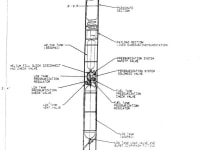A liquid fuel missile was designed, built and tested. Design calculations for the two engines and propulsion systems were performed and the engines were constructed to those specifications. A static test stand was constructed and instrumented to evaluate engine performance during full duration static firings. The engine proved successful and it was incorporated into the flight vehicle. The first missile was successfully launched. In the area of guidance, it was decided that the rocket should be ballistic and only fin stabilized. The initial vehicle parameters were:
Thrust: 1000 lbs.
Burn time: 15 sec
Oxidizer: Liquid Oxygen
Fuel: Kerosene
Feed system: 3000 psi nitrogen
Guidance: Fin stabilized
The rocket when launched left the rail at an angle of 45 degrees to the centerline of the vehicle. It traveled 13,000 ft at a speed near mach 1 before reaching a target in 12.8 sec.
A second liquid fuel missile was also designed, built and tested, but this time, it was equipped with a rocket engine with a plug center body as to vary the engine´s throat area for better performance. When putting kerosene to work with lox and using both of these energies combined, the following is accomplished:
When using a pressure fed liquid chemical, the thrust chamber is the key to establishing its weight and a vehicle performance. By increasing the chamber pressure in the engine, it produces several effects:
The engine will tend to be smaller and perform better due to an increased area ratio and to a much lesser extent, an improved combustion efficiency, therefore, the engine weight and propellant quantity will tend to decrease while thrust will increase.The plug center body will provide for a greater performance for the given length. So, the first energy, the pressure built up within the engine´s combustion chamber (500 psi),when released, delivers the product gases through the center body nozzles at a supersonic speed providing thrust. These,in turn, discharge gases into a spike shape wall of the center body, allowing the exhaust gases to expand through an isentropic or constant entropy process. In so doing, the nozzle efficiency is maximized and no energy is lost because of a turbulent mixing in the exhaust flow.A 15 % additional thrust is obtained from a secondary flow acting on the tapered base.All this results in a 50 %increase in thrust as tested. The new acquired parameters were:
Thrust: 1956.46 lbs
Burn time: 15 sec
Oxidizer: Liquid Oxygen
Fuel: Kerosene
Chamber pressure: 500 psi
Feed system: 3000 psi nitrogen
Guidance: Fin stabilized
The rocket when launched left the rail at an angle of 45 degrees to the centerline of the vehicle. It traveled 13,000 ft at a speed near mach 2 before reaching a target in 6.5 sec.
Conclusion: This engine retrofit design can provide a missile with a fast retaliation capability over what it is currently used for defense purposes.The missile can be maneuvered using differential thrust vectoring instead of heavy gimbals.
The vehicle uses from 25 to 30% less fuel at low altitudes where the greatest need of thrust is needed.
Like this entry?
-
About the Entrant
- Name:Ignacio Quesada
- Type of entry:individual
- Software used for this entry:google´s
- Patent status:pending





